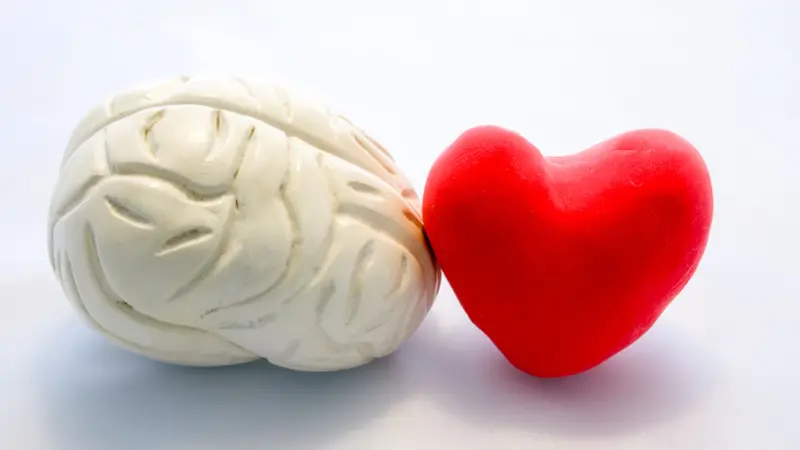

Emerging

Emerging
Rhythms of the Heart: Improving Mood With Vagus Nerve Toning
by Kirby Baldwin
While most people consider the brain to be the power center of the body, the heart is stronger in several ways. In research pioneered by the HeartMath Institute in the 1990s, the heart has been found to be 40 to 60 times stronger than the brain electrically and about 100 times stronger magnetically.
HeartMath studies heart rate variability (HRV), which measures the naturally occurring beat-to-beat changes in heart rate and rhythms, and is a key marker of overall health, resiliency and longevity. HeartMath discovered people could train themselves to improve their HRV and, as a result, their ability to regulate emotions by using breath as a type of biofeedback.
Central to this work is the vagus nerve, a main component of the parasympathetic nervous system that carries signals at an unconscious level between the brain, heart and digestive system. Due to its many functions, particularly controlling mood, researchers have targeted the vagus nerve in treating depression, anxiety and other psychiatric disorders.
According to a 2018 study, “Vagus Nerve as Modulator of the Brain-Gut Axis in Psychiatric and Inflammatory Disorders,” published in Frontiers in Psychiatry, “Treatments that target the vagus nerve increase the vagal tone and inhibit cytokine production. Both are important mechanisms of resiliency. The stimulation of vagal afferent fibers in the gut influences monoaminergic brain systems in the brain stem that play crucial roles in major psychiatric conditions, such as mood and anxiety disorders. Since the vagal tone is correlated with capacity to regulate stress responses and can be influenced by breathing, its increase through meditation and yoga likely contribute to resilience and the mitigation of mood and anxiety symptoms.”
Vagal tone tells us how well the vagus nerve is functioning, and it is measured indirectly by HRV. A toned vagus nerve can help regulate the nervous system and improve digestion, heart health and breathing rate. It can also counter the body’s “fight” response and help us relax and bounce back from daily stresses by boosting the “rest-and-digest” response, which also boosts HRV.
Because the vagus nerve is integral to the gut-brain connection, Michael Ruscio, DNM, DC, writes that lifestyle practices that are good for the gut and brain, like diet, exercise and deep breathing, can improve vagal tone. The Cleveland Clinic states that the vagus nerve can be naturally strengthened through meditation, massage, music therapy and cold-water immersion.
Other non-invasive methods of stimulating the vagus nerve include lightly tapping the chest while holding the breath, as well as light-to-moderate massage in areas near the vagus nerve. Because the nerve connects to the throat, gargling with salt water and laughing have also been proposed as potential interventions.
The U.S. Food and Drug Administration has approved electrical vagus nerve stimulation (VNS) for the treatment of drug-resistant epilepsy and depression, and there are ongoing studies to expand its use for other health conditions and disorders. This is an invasive solution, as the device is surgically implanted under the skin on the chest.
Bruce Cryer, co-founder and former CEO of HeartMath, says, “We could all use a helping hand to get into our happy place” in these uncertain times. The 40-year wellness leader recently turned to Sensate, a new personal device designed to help people improve HRV and derive calming benefits without the need for extensive training in meditation or breathing techniques.
Developed by Stefan Chmelik, a physician, Sensate is a palm-sized device that is simply placed on a person's chest as it emits stress-relieving sound waves directly to the nervous system using bone conduction. Similar to the comfort a person experiences when a purring cat lays on their chest, Sensate causes the chest to resonate sound, which signals the vagus nerve to relax. When used over time, the device can train (or retrain) the vagus nerve to default to this calming state.
In a 2022 study, adults with and without anxiety and depression disorders used Sensate for an average of three and a half months, five to six days per week. After the test period, more than 70 percent of the participants reported low, mild or normal stress levels. More than 65 percent of the participants with anxiety disorder and over half of those with a depressive disorder reported an improvement in their condition.
Chmelik says, “Stress is a ‘global catastrophe’, and with a chronically stressed public, there is no will or ability to address all the other issues facing us. My goal in developing Sensate was to enable people to self-regulate more efficiently. I want to create a tipping point to create a more conscious world. As more people become aware of their breath and its connection to stress, and take advantage of the powerful tools of meditation, breath and other tools like Sensate, hopefully that tipping point is reached.”
Kirby Baldwin writes and edits for KnoWEwell.
This article was originally published in Natural Awakenings magazine, February 2023 edition.


 By
By

